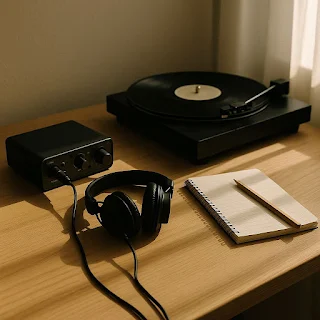In August 2019, the world was buzzing with the usual rhythms of summer: outdoor
concerts, open mic nights, festival road trips, and late-night playlists shared
between friends at face value, nothing seemed unusual.
Music was alive, abundant, and as unpredictable as ever but underneath that surface energy, something subtle was shifting—in how we listened, how we created, and how we connected through sound.
What we didn’t know then was that this moment would soon become a kind of
musical time capsule—a "before" picture of an art form on the brink
of transformation.
A Softer Kind of Sound Was Emerging
While popular music always celebrates spectacle, 2019 saw a quiet rise in more
introspective, low-fidelity recordings, Bedroom-made music and minimalist
production gained traction among listeners craving sincerity over saturation.
Listeners gravitated toward:
Lo-fi and ambient instrumentals
Stripped-down acoustic sessions
Slow, reflective melodies with minimal percussion
This wasn’t a rejection of technology, It was an embrace of subtlety. Many
artists were exploring the boundaries between silence and sound—using layered
textures, field recordings, and analog warmth to create mood-driven pieces.
Music as a Journal, Not Just a Product
The rise in self-produced work coincided with a broader creative movement: music
as journaling, Artists were recording rough demos, voice memos and layered
loops not to perfect them but to preserve them.
They shared their process openly, treating creativity as a living, breathing experiment.
This shift meant:
More vulnerability in songwriting
Raw vocals that sounded closer to whispers than performance
Home recordings released without industry polish
It reminded us that music could be more than entertainment, It could be a
diary.
Listening Became More Intentional
Streaming platforms, smart playlists, and noise-canceling headphones made music
more accessible than ever but that access also inspired reflection, In August
2019, many listeners were tuning out the algorithm and rediscovering:
Full-length albums as immersive experiences
Analog formats like vinyl and cassette as ritual
Personalized playlists curated by emotion, not just tempo
The act of listening became less about passively filling silence and more about
choosing what to let in.
Soft-tip: Many found joy in starting their own vinyl collections
or journaling to music using compact turntables and vintage-style Bluetooth
players.
Tools for Creation Were Shrinking
On the creative side, music production became increasingly compact. Artists
were creating tracks on:
Tablets with portable MIDI controllers
Pocket-sized recorders and loopers
USB microphones plugged into basic laptops
This democratization of production tools gave rise to a broader range of
voices. Music became something you could start on a coffee break and finish in
a bedroom studio.
Subtle gear bundles offering affordable interfaces and
plug-and-play mics allowed new creators to jump in without a steep learning
curve.
The Power of Silence
It wasn’t just about sound. Silence was becoming part of the music again.
In a noisy world, many creators began incorporating longer pauses, subtle
fades, ambient spaces and breath into their compositions. Listeners embraced
these choices. Songs no longer rushed to the chorus. Intros became longer.
Outros lingered.
Music felt more like meditation.
Community Through Quiet
Smaller gatherings in August 2019 reflected this mood. Tiny desk-style
concerts, park acoustics, and late-night jam circles drew more emotion than
noise. People showed up not just for performance, but for presence.
Live experiences became:
More collaborative than performative
Built around shared silence and space
Less about spectacle, more
about shared intention
Even playlist creators and radio hosts began introducing themes like slow
living, creative solitude, or mindful mornings.
The Seeds of Resilience
Although no one knew what was coming, this period of creative introspection
served as unintentional preparation for what lay ahead.
By creating music with:
- Smaller tools
- Flexible routines
- Home-based workflows
Artists unknowingly developed the habits that would sustain them through
isolation months later. What was once stylistic choice would soon become
survival instinct.
What It Felt Like to Listen in August 2019
Ask any music lover what they were listening to in August 2019, and chances are
the memory is vivid. Maybe it was a road trip album. Maybe it was a song they
looped during a late summer walk. Maybe it was a melody that helped them
exhale.
The emotion behind music felt heightened—not because we knew what was coming,
but because life, as it was, already needed soundtracks of slowness and hope.
Reconnecting With Music Spaces
Record stores, open mic cafés, and listening bars were still places of
gathering. Many communities saw a quiet revival of local scenes. People weren’t
looking for big acts. They wanted honest connection through shared rhythm.
DIY music corners and analog revival zones became:
Places to discover undiscovered sounds
Platforms for hyperlocal talent
Spaces where physical media met modern taste
Preparing for the Digital Pivot (Without Realizing It)
Creators who leaned into:
Remote collaboration tools
Livestream experiments
Audio journaling or podcast hybrids
Were unknowingly sketching the blueprint for the pandemic-era creative world.
In retrospect, August 2019 wasn’t just reflective. It was adaptive
Compact livestream kits and mobile audio rigs quietly helped artists build hybrid studios ready for the shift to digital
Final Thoughts: A Moment That Meant More Than We Knew
August 2019 didn’t scream change. It whispered it.
From the quiet rise of lo-fi journaling to the stripped-down performances in
quiet parks, something essential was happening: a rediscovery of music’s
emotional utility.
People were asking:
What does this song say about me?
How does this sound help me feel?
Who am I when I play, write, or listen?
In many ways, the answers we found then would help carry us through what came
next.
It wasn’t a revolution of volume.
It was a return to resonance.
